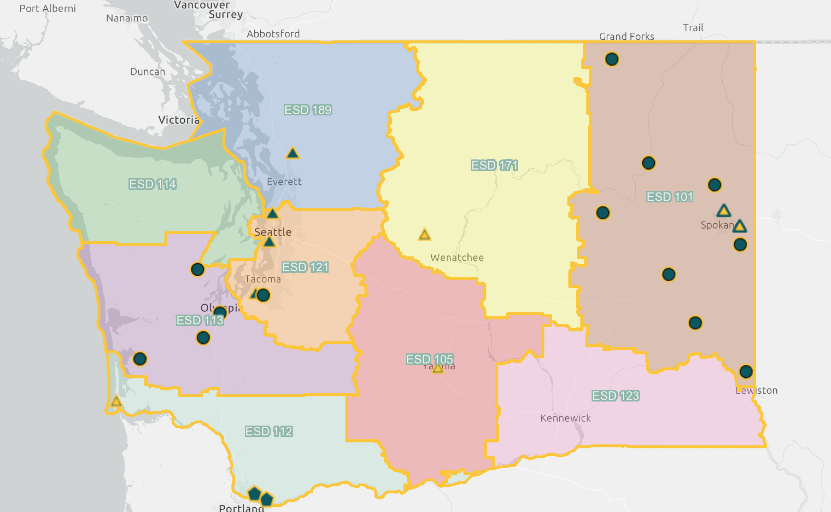Early Childhood Special Education
Early Childhood Initiatives & Updates
Contact Information
Special Education
360-725-6075
This web page contains technical assistance resources for special education staff, administrators, and families of preschool children who receive special education services. The resources are organized according to the three federal early childhood indicators of the State Performance Plan. The State Performance Plan is Washington's plan for improving school district performance on the federally required program indicators. For more information on the indicators, please visit the Technical Assistance Web page.
Guidance for Families: Young Children and Special Education is an online resource that explains the steps involved when evaluating a child for special education services through the school district. OSPI also maintains a more general resource, Guidance for Families: Special Education Services.
Early Childhood Special Education Initiatives Activity Map
This application will serve as a tool for state, regional, and local level teams to assess their progress towards creating access to high quality early learning programs for children with disabilities with an Individual Education Program (IEP). With this application, teams will also have the opportunity to view which districts in Washington state are engaged in early childhood special education initiatives that are intended improve the quality of instructional and systemic practices with the use of inclusionary practices, coaching supports, and targeted technical assistance, driven by data-based decision making. Users of this application can disaggregate the data by school year, legislative session, and more.
Click on the map below and then select ECSE Application 2024 to access the interactive map.

School Facility Closures
In partnership with the Washington State Early Childhood Special Education Coordination Team, OSPI Special Education has developed guidance on the Provision of Services to Children with Disabilities in Early Childhood Programs during School Facility Closure. The guidance document addresses early childhood transition from IDEA, Part C to Part B, including the role of school districts in the initial eligibility process. Other topics include child outcome summary (COS) entry and exit ratings, and considerations for students transitioning to kindergarten during a school facility closure.
For additional information, please contact Cassie Martin, Executive Director of Special Education.
Early Learning Programming
Governor Inslee has requested the Office of Superintendent of Public Instruction (OSPI) work in collaboration with the Department of Children, Youth, and Families (DCYF) to identify near-term administrative efficiencies and long-term strategies to improve the alignment and integration of high-quality early learning programs. An important goal of this work is to streamline regulatory functions across various programs aimed at kindergarten readiness that allow for the braiding of multiple funds in school- and community-based classrooms.
PreK Inclusion Finance Toolkit
OSPI with the help of the Early Childhood Technical Assistance (ECTA) Center presented the PreK Inclusion Finance Toolkit.
- PreK Inclusion Finance Toolkit: Presentation Slides | Recorded Presentation (coming soon!)
- ECTA Center’s Preschool Inclusion Finance Toolkit
Early Learning Resources
- Social Emotional Learning Pathways
- Outdoor Learning: OSPI Learning & Teaching shares research on the benefits of outdoor learning to promote equity and inclusion, cites alignment to state standards, and offers current examples of school district programs from PreK through 12th grade.
- Learning Pathways in Numeracy: Addressing Early Numeracy Skills | Learning Pathways in Numeracy: Spanish
- Early Literacy Pathways
- Washington State Early Learning and Development Guidelines Birth Through Third Grade
- Washington State Comprehensive Literacy Plan: Birth to Grade 12
- Washington State Full-day Kindergarten Guide
State Systemic Improvement Plan (SSIP)
- Cross-Cultural Training Recommendations: Tribal Review of the Washington Pyramid Model
- SSIP Evaluation Plan (Revised January 2025)
- 2021 SSIP Report
- SSIP Theory of Action (Revised January 2025)
- Washington SSIP Logic Model
- 2020 SSIP Planning Report
- Pre-K Early Literacy - Action Research Project Brochure
- Phase I | Phase I Executive Summary
- Phase II | Phase II Executive Summary
- Phase III - Evaluation Report for Year One: FFY 2015
- Phase III - Evaluation Report for Year Two: FFY 2016
- Phase III - Evaluation Report for Year Three: FFY 2017
- Phase III - Evaluation Report for Year Four: FFY 2018
- Phase III - Evaluation Report for Year Five: FFY 2019
Early Childhood Least Restrictive Environment (LRE) Indicator 6
Early childhood LRE refers to the Least Restrictive Environment where children receive their special education services.
Early Childhood Outcomes Indicator 7
Early childhood outcomes for preschool children receiving special education services are reported each year to OSPI. The Child Outcome Summary Form (COSF) is the tool used by Washington to measure early childhood outcomes.
Part C to B Transition Indicator 12
Part C to B Transition refers to children transitioning from Early Intervention (Part C) to Early Childhood Special Education (Part B) at age three. Indicator 12 requires that children transitioning from Part C to Part B have their initial IEP in place by the third birthday.
External Resources
- ECTA Center: Improving Systems, Practices and Outcomes
- Key Preschool Principles and Practices Underlying the IEP Process
- IRIS Center: Online Learning Modules, Case Studies and More, Funded by the Office of Special Education Programs
- National Center for Pyramid Model Innovations NCPMI
- National Center for Systemic Improvement – Helping states transform systems to improve outcomes for infants, toddlers, children, and youth with disabilities






